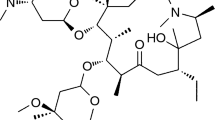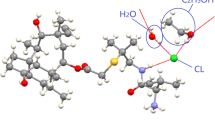Abstract
The solubility of erythromycin acetone solvate and dihydrate was experimentally determined in aqueous acetone mixtures at different temperature. It has been demonstrated that solubility curves of the two solvates intersected at given solvent composition at various temperature, suggesting a transition behavior between two solvates. The induction period of acetone solvate at different supersaturation was measured by the laser monitoring observation technique. Based on classical homogeneous nucleation theory, the solid-liquid interfacial tension and surface entropy factor were calculated from the induction period data. From the surface entropy factor values calculated, together with surface morphology observation by the atomic force microscopy (AFM), the growth mechanism of erythromycin acetone solvate is consistent with continuous growth mode.
Similar content being viewed by others
References
A. Nangia, Cryst. Growth Des., 6, 2 (2006).
D. Chopra and T.N. Guru Row, Cryst. Growth Des., 7, 848 (2007).
M. Kitamura, Cryst. Growth Des., 4, 1153 (2004).
G. Cindy, K. C. Hezekiah and V. S. Ann, Rapid Commun. Mass Sp, 14, 878 (2000).
F. Yoshinobu, F. Yomoaki and Y. Yuko, Chem. Pharm. Bull., 31, 4029 (1983).
G. Madrasa and B. J. McCoy, Chem. Eng. Sci., 59, 2573 (2004).
M. Kitamura and S. Hironaka, Cryst. Growth Des., 6, 1214 (2006).
A. S. Gregory, G. S. Joseph and H. P. Stowell, J. Pharm. Sci., 86, 1239 (1997).
I. Miroshnyk, L. Khriachtchev and S. Mirza, Cryst. Growth Des., 6, 369 (2006).
M. N. Butler and W. J. Weber, Environ. Sci. Technol., 39, 2301 (2005).
A. E. Graham, A.V. Thomas and R. Yang, J. Org. Chem., 65, 2583 (2000).
Z. Z. Wang, J. K. Wang and L. P. Dang, Ind. Eng. Chem. Res., 46, 1851 (2007).
A. Bernardo, C. E. Calmanovici and E. A. Miranda, Cryst. Growth Des., 4, 799 (2004).
H. X. Hao and J. K. Wang, J. Cryst. Growth, 274, 545 (2005).
Y. L. Geng, D. Xu and X. Q. Wang, J. Cryst. Growth, 280, 266 (2005).
A. Lancia, D. Musmarra and M. Prisciandaro, AIChE J., 45, 390 (1999).
M. Kitamura and K. Nakamura, J. Cryst. Growth, 236, 676 (2002).
K. Selvaraju, R. Valluvan and S. Kumararaman, Mater. Lett., 60, 1549 (2006).
R. J. Davey, Curr. Topics Mater. Sci., 8, 454 (1982).
Author information
Authors and Affiliations
Corresponding author
Rights and permissions
About this article
Cite this article
Wang, Z., Fang, W. & Li, Y. Solvated behavior and crystal growth mechanism of erythromycin in aqueous acetone solution. Korean J. Chem. Eng. 31, 120–124 (2014). https://doi.org/10.1007/s11814-013-0199-0
Received:
Accepted:
Published:
Issue Date:
DOI: https://doi.org/10.1007/s11814-013-0199-0




